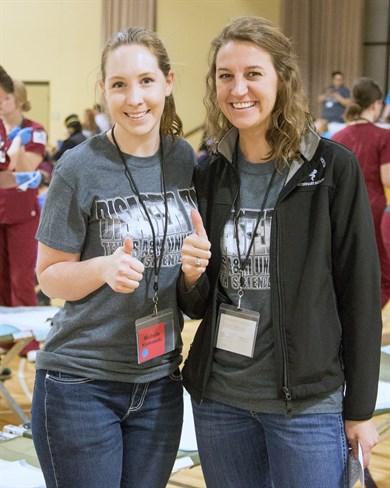VetMed Students Get Emergency Training During ‘Disaster Day’
 Thirty Texas A&M College of Veterinary Medicine & Biomedical Sciences (CVM) students sprang into action on March 30 as first-time participants in the College of Nursing’s annual Disaster Day, the largest student-run mass casualty simulation event in the country.
Thirty Texas A&M College of Veterinary Medicine & Biomedical Sciences (CVM) students sprang into action on March 30 as first-time participants in the College of Nursing’s annual Disaster Day, the largest student-run mass casualty simulation event in the country.
Led by Michelle Kurkowski and Laura Hurst, veterinary students and co-presidents of the Student One Health Association, the 30 students joined close to 300 nursing, medical, and pharmacy students employed to act as care providers for more than 400 volunteers, who portrayed victims of a hurricane disaster.
The annual, interdisciplinary event—held at the Central Baptist Church’s Family Life Center in Bryan—incorporates all of the medical disciplines within the Texas A&M University System to provide students with the knowledge and skills necessary to respond in an emergency situation, according to Kurkowski.
Kurkowski and Hurst served as the veterinary medicine liaisons in charge of setting up the veterinary side of the Disaster Day scenario.
The two wrote three vet-med cases that were treated during the activity—including a child bitten amidst a dog fight, a man and his two dogs showing signs of a bacterial disease, and a girl suffering head trauma who was brought in with her service dog—in an effort to incorporate both human and animal medicine into the day’s events.
“The vet students greatly enjoyed the chance to interact with the other colleges and get in on the main action. They also remarked that they learned a lot clinically,” Kurkowski said.
“The medical and nursing students began to seek out the veterinary teams for consultations and assistance when needed; they even began to consult with the veterinary teams on cases that were not originally written as med-vet interface cases,” she said. “One student remarked that it was the first time that he had seen the concept of ‘one health’ truly in action.”
In addition, members of Texas A&M’s Veterinary Emergency Team (VET)—the largest and most sophisticated veterinary medical disaster response team in the country—set up tents outside of the center to support the cause, helping vet students understand what it’s like to deploy for a disaster on the veterinary side by working through animal cases.
“There is no question this is valuable,” said Deb Zoran, professor in the Department of Small Animal Clinical Sciences and VET member. “It is a great experience that allows the fourth-year veterinary students opportunities to practice being team leaders. Perhaps most importantly for the first-, second-, and third-year veterinary students, it is the first time they’re introduced to disaster response and the concept of triage and stabilization. It (this training) will help them as they continue in school because it’s just another way of developing the skills of thinking things through and problem solving.”
Kurkowski and Hurst also tied in an educational component to Disaster Day by providing handouts and bringing in CPR dummies after the morning simulation to teach participants about canine CPR.
“Animals are always affected when disasters hit, and canine CPR is a really popular topic with non-veterinary students because most people have pets and would like to know how to respond in an emergency situation,” Kurkowski said.
While the VET team participated in scenarios two years ago, the March 30 event represents the first time the CVM has integrated with the human side of the event. Kurkowski said she hopes to establish a greater presence for CVM in the future.
